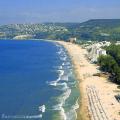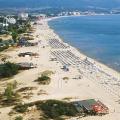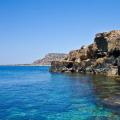Satellite map of Moscow allows you to view in great detail any object in Moscow using satellite images high resolution... By changing the scale of the map of Moscow from a satellite, you can zoom in and out of streets, houses and see how the most interesting places in the capital.
Moscow, for the first time it is mentioned by a chronicle dated 1147. The capital is located on the banks of the Moskva River between the great navigable rivers of Russia Oka and Volga. The capital is economically located at the crossroads of very ancient trade routes, which served its development and prosperity.
Modern Moscow is a large transport hub, which has: four international airports, 160 metro stations (their total length reaches 264 km), 9 operating railway stations carrying an average of 9 million people per day.
For example, you can take a fascinating journey along the Moscow metro because each station will surprise you with its beauty: Kievskaya - with magnificent mosaics, Komsomolskaya - with crystal chandeliers, Revolution Square - with the superiority of bronze sculptures, etc. The first metro line was opened in 1935. Since then, some stations have been renamed, however, two of them: Kropotkinskaya and Mayakovskaya are marked by UNESCO as unique architectural monuments.
There are over 60 theaters and 75 universities in Moscow. There are more than four thousand libraries in the capital, the largest of them is the library named after Vladimir Lenin, where not only old books are kept, but also ancient manuscripts.
Any city in the world can envy the location in the building Moscow Kremlin collections of famous paintings by Russian artists of different eras of the Tretyakov Gallery. The Armory contains regalia that were used for coronation, clothing, precious items, weapons and other valuables. The diamond fund located in the Kremlin is famous for its collection of rare precious stones, gold items, it was significantly replenished during the reign of Catherine II.
On the east side, the Kremlin is adjacent to the historic district of Moscow China town... It preserved architectural monuments 17-20 centuries. The most beautiful of all Moscow squares and famous for its ancient lanterns, fountains, flower beds is Pushkin Square. Here in 1950 the monument to A.S. Pushkin was moved from Tverskoy Boulevard, where it is located today.
White columns and a chariot of four horses driven by Apollo adorn the building of the Great Bolshoi Theater, located on Theater Square. In 1786, according to the project of the famous architect V. Bazhenov, the most beautiful of the buildings, the Pashkov House, was built.
The pedestrian street of Moscow is always lively and welcoming Old Arbat... On it you will see musicians and poets, artists, mime actors, you can buy souvenirs for yourself, which are presented here in a large number, or sit in one of the cafe-restaurants... In the neighborhood of the Arbat there are streets where famous writers, poets and politicians lived.
New Arbat- this is already a modern cultural center, which houses high-rise 26-storey buildings, the Ministry of Foreign Affairs and Foreign Trade, State University them. MV Lomonosov, hotels and much more.
Near the Kremlin, overlooking the Moskva River, is the Cathedral of Christ the Savior, the construction of which, for various reasons, dragged on for about half a century, later it was destroyed in 1931. Today, work is underway to restore this historical monument.
Centers of music and cultural life Moscow are Concert hall(1940) and the Tchaikovsky Conservatory, its building was built by the architect V. Bazhenov at the end of the 18th century.
In 1939 was opened All-Russian Exhibition Center, where the agricultural exhibition of the USSR was held, the sculpture of a collective farmer and a tractor driver became its emblem. The exhibition, which occupied an area of 136 hectares, lasted a whole year, and was seen by about three and a half million people. The enormous success of the exhibition was confirmed by the fact that in 1940, and after the war in 1954, and in 1958 (merging with the construction and industrial) the exhibition worked again, the territory was expanded to 207 hectares. Today it is a State Joint Stock Company called the All-Russian Exhibition Center, famous not only for exhibitions, but also for holidays, shows, fairs and various art festivals.
On the Poklonnaya Hill a park with the same name was laid near the granite monument to the Victory in the Great Patriotic War of 1941-1945. Initially, in 1958, a granite sign was installed, and later for the construction of this memorial, 194 million rubles were collected from the subbotniks held in the 70-80s. The government has repeatedly allocated money for the construction of these historical monuments.
Today there are: the Victory Monument, the Central Museum of the Great Patriotic War, the Victory Park, the Church of St. George the Victorious, a mosque in memory of Muslim warriors, a synagogue in memory of Jews and other monuments.
Satellite map of Russia how many in this offer!
And if you are interested satellite view in real time?
Long ago we got used to the process of globalization and the Internet.
We can communicate with anyone through the World Wide Web.
But not so long ago, progress in this direction has stepped forward.
In this article you will find map of Russia from satellite in real time online
(you can also find any cities on the map, for example) and a map of Russia webcams.
If you want to view Planet Earth in REAL TIME as if from a satellite, use the Google Earth provided below.
Use the mouse wheel to zoom in and out. If you do not have Google Earth, you will be prompted to do so. If you entered through the Opera browser, viewing is not possible. This is best done in Firefox and Google Chrome browsers.
Enter any object you are interested in in the window and click "Forward!":
The dream of many science fiction writers about the "vidophone", such as the Strugatsky brothers, for example, has come true. Now Russia is available in real time to anyone who has access to the Internet. We can communicate with each other not only by sending messages to a faceless person on the other side of the monitor, but also to see and hear him.
Live communication is difficult to overestimate. And that's great. Now, having bought a web-camera, anyone can show themselves to the whole world and compatriots in particular. All the same, it is much more pleasant to communicate in your native language than trying to translate a foreign language online. This is not given to everyone. Russia in real time- a miracle of science and technology.
By opening a site like the one below, for example, anyone can see another city, see what is happening now for several thousand kilometers.
Now distance is not a hindrance to communication. We can find everything Russian webcams, connect to this broadcast and observe, listen, talk and convey your emotions to the interlocutor. I think everyone agrees that webcams are great!
And another way to contemplate a live satellite view, this is a wonderful program for displaying a full three-dimensional model of our planet, you can even see the terrain, the mountains are high, the water in the seas sways, and special cultural monuments presented in the mode - Google Planet. If you do not have Google Earth, you will be prompted to do so. If you entered through the Opera browser, viewing is not possible. This is best done in Firefox and Google Chrome browsers.
From Google or Yandex, does it feel like you're in a time machine?
This is especially evident in the areas in which everything is changing very quickly: a house that has been standing for several years is displayed on the Google map as a stack of concrete slabs at a construction site, and in the place where, as you know, there is a high-speed transport interchange, it turns green grass and dandelions turn yellow (well, let's say, dandelions on the map cannot be seen from the satellite, but they are easy to speculate).
This is because satellite maps Is not a direct satellite image. This is the result of the most complex processing of maps from the satellite, which takes quite a long time. So not on Google Maps? neither on Yandex, nor in mail.ru you will find "fresh cards".
And yet they are on the web. And you can actually look at our old Earth from a satellite, having seen the picture taken yesterday.
Today there are two most used image generating programs that are available to the general public: MODIS and DMSP, which I would like to talk about today.
About the third program - I told in the article
MODIS sensors are now installed on two satellites, the DMSP program monitors data from about eight independent satellites.
DMSP is a long-term Earth monitoring program providing operational global meteorological, oceanographic and solar geophysical information. Currently, the GLOBAL – T band database contains information for the period 1995-2006.
I will say right away that information from this service will be of interest only to specialists - those who know what and how to look for. The entertainment of Google Earth with its flights and 3d maps is not here. Stingy scientific information. layers encoded with abbreviations understandable only to specialists.
There are services that allow you to more or less conveniently view these maps. For instance, . But if you don't know what to look for, this is unlikely to help you:
However, look at the list of others, perhaps you will be more fortunate and you will see our planet in all its glory. Don't forget to write about it in the comments.
I must confess that these maps did not inspire me, but on the page of the Space Research Institute
Of the Russian Academy of Sciences under the name "" I saw absolutely amazing pictures of an oil spill. It's amazing how much you can learn from open source information!
Here are the photos from the mentioned page:
On April 21, a fire continued on the platform, which is clearly seen in the optical images of the MODIS sensor presented below. The arrow points to the burning platform. A smoky plume is clearly visible, which spreads in a southerly direction.
Image received on April 21, 2010 at 16:05 UTC, with a resolution of 250 m.
Fragment of the MODIS Aqua image (composite 1, 4, 3 channels), resolution 250 m.
The image was taken on April 25, 2010 at 18:55 UTC, also in the solar flare zone. The growth of the spot is clearly visible within 2.5 hours from the moment of the MERIS Envisat survey.
Fragment of the MODIS Terra image (composite 1, 4, 3 channels).
Image received on April 29, 2010 at 16:50 UTC, with a resolution of 250 m. Sun flare zone. It is clearly seen how the vortex processes characteristic of the Gulf of Mexico affect the slick.
Over the past three days, the slick has greatly increased in size and reached the coast. It even got on western part the Mississippi Delta.
Fragment of the ASAR Envisat image, received on May 5, 2010 at 03:57 UTC in the WSM mode, with vertical polarization of emission and reception with a resolution of 75 m.
(© ESA 2010)
Having become interested in the topic, I googled a little and went to a wonderful one.It turns out that for several years now a wonderful project has been operating in Russia in the field of using images of the Earth from space in scientific and applied research, education, design, tourism and local history. The site contains many interesting projects based on the analysis of satellite images. Consider, for example, the “Living Card” competition for schoolchildren, which has been held for two years now.

"Live card"- an annual interactive Internet competition for schoolchildren to work with images of the Earth from space. The purpose of the competition is to increase the availability of information about satellite monitoring and the possibilities of using space images in education, science, and practice.
The theme of this year's competition is borders Russian Federation... What are the only tasks for the delimitation and demarcation of disputed sections of state. borders of the Russian Federation! The students have an amazing feeling of involvement in an important, necessary, state matter.
Well, it is interesting not only for children to see how the tundra changes during the development of, for example, the Samotlor deposit. I watched with pleasure how, over time, new roads appear, towers appear and ... the tundra changes.
Development of the northern part of the Samotlor field
Traditionally, images of the Earth from space are used in geography lessons: they are presented as illustrations in textbooks and atlases. but space images- one of the best objects for building intersubject connections, demonstrating the processes and phenomena occurring on our planet.
Pictures can be used as an interesting material in the lessons of geography, ecology, biology, natural science, chemistry, the basics of life safety, physics, astronomy, computer science, mathematics, technology, history, social science.
Absolutely amazing for me was the fact that for some three and a half thousand rubles a real station for receiving space information can be put in school, which can be controlled by the children themselves and work not just with maps from a textbook, but with real scientific material of the 21st century!
Laboratory "Earth from Space"- a set of various possibilities for using space information in Russian schools with their modest budget.
The stations that are part of the laboratory make it possible to receive space images for lessons and conduct own research- study changes in vegetation and snow cover, meteorological and ice conditions, floods, hurricanes, ocean surface temperature and ocean currents, fires, volcanic activity, dust storms. The use of stations for receiving space information allows you to receive images directly to a computer at the school in real time, regularly and free of charge.
Station kits contain detailed ones that include both theoretical materials showing the main possibilities of using space images in training, and the development of practical exercises, as well as student worksheets... These materials can be used both in whole and in part - choosing those topics that best meet the interests and tasks of the teacher.
Another interesting project in this area is the Kosmosnimki website.
"Cosmos images"- ScanEx RDC's project to develop the Scanex Web GeoMixer technology platform for Web-Gis and to create a single basis for satellite images for the entire territory of Russia. The project consists of the stages of creating separate mosaics of satellite images for cities and regions of the Russian Federation. A single spatial framework is created to be used as a base in geographic information and web mapping services. Technological development is aimed primarily at the development of means of access to spatial data and remote sensing data on the Internet.
The first implementation of the Kosmosnimki project was an online store with the ability to purchase online fragments of LandSat-4, LandSat-5, LandSat-7 and IRS-1C / 1D images in JPEG format. In 2007 the project “New! Kosmosnimki ”, in which the purchase of images online became one of the services of the system of access to mosaics of images and maps, and all the mosaics were laid out for free viewing.
On the site, you can very conveniently select satellite images for any point in Russia, the reception of images has been available over the past ten years, which allows you to trace the dynamics of changes in any processes in a certain territory. Alas, pictures of acceptable resolution are not available for free access, but they can be bought for not very big money.
The price level can be understood from the example on the website: to buy (~ 1000 sq. Km) from IRS images, you will need 6000 rubles. But the print of such a fragment can be spread over the entire wall (~ 1m by 1m when printing 150 dpi).
You may also be interested in the information on the following keywords, which are usually searched for on my site




